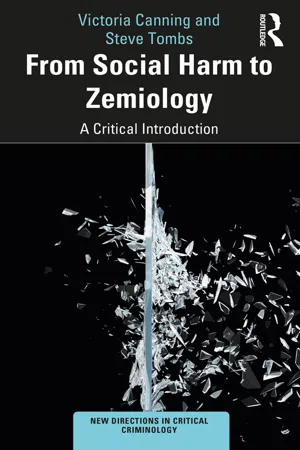
- 156 pages
- English
- ePUB (mobile friendly)
- Available on iOS & Android
About this book
This book outlines key developments in understanding social harm by setting out its historical foundations and the discussions which have proliferated since. It examines various attempts to conceptualise social harm and highlights key sites of contestation in its relationship to criminology to argue that these act as the basis for an activist zemiology, one directed towards social change for social justice. The past two decades have seen a proliferation of debate related to social harm in and around criminology. From climate catastrophe and a focus on environmental harms, unprecedented deaths generating focus on border harms and the coronavirus pandemic revealing the horror of mass and arguably avoidable deaths across the globe, critical studies in social harm appear ever more pressing.
Drawing on a range of international case studies of cultural, emotional, physical and economic harms, From Social Harm to Zemiology locates the study of social harm in an accessible fashion. In doing so it sets out how a zemiological lens can moves us beyond many of the problematic legacies of criminology. This book rejects criminologies which have disproportionately served to regulate intersectional groups, and which have arguably inflicted as much or more harm by bolstering the very ideologies of control in offering minor reforms that inadvertently expand and strengthen states and corporations. It does this by sketching out the contours, objects, methods and ontologies of a disciplinary framework which rejects commonplace assumptions of 'value freedom'. From Social Harm to Zemiology advocates social change in accordance with groups who are most disenfranchised, and thus often most socially harmed.
An accessible and compelling read, this book is essential reading for all zemiologists, critical criminologists, and those engaged with criminological and social theory.
Frequently asked questions
- Essential is ideal for learners and professionals who enjoy exploring a wide range of subjects. Access the Essential Library with 800,000+ trusted titles and best-sellers across business, personal growth, and the humanities. Includes unlimited reading time and Standard Read Aloud voice.
- Complete: Perfect for advanced learners and researchers needing full, unrestricted access. Unlock 1.4M+ books across hundreds of subjects, including academic and specialized titles. The Complete Plan also includes advanced features like Premium Read Aloud and Research Assistant.
Please note we cannot support devices running on iOS 13 and Android 7 or earlier. Learn more about using the app.
Information
1
Understanding social harm
Introduction
Haunted by ‘the criminal man’?
Case study example: policing dangerous dogs, Lombroso style
The term pit bull is an elastic, imprecise and subjective phrase ranging from the American pit bull terrier breed at its narrowest end through to a term which includes a number of bull breeds. It is also used to describe dogs similar in appearance e.g. block heads, white chest markings or brindle coats.(RSPCA, 2016: 8)
Table of contents
- Cover
- Endorsements
- Half Title
- Series Information
- Title Page
- Copyright Page
- Contents
- List of figures
- List of tables
- List of boxes
- Preface
- Acknowledgements
- Introduction: Social harm matters
- 1 Understanding social harm
- 2 Towards social harm and zemiology
- 3 A provisional typology of harm
- 4 The relations and ontologies of harm
- 5 Doing zemiology
- Conclusion: Activist zemiology for social justice
- Index